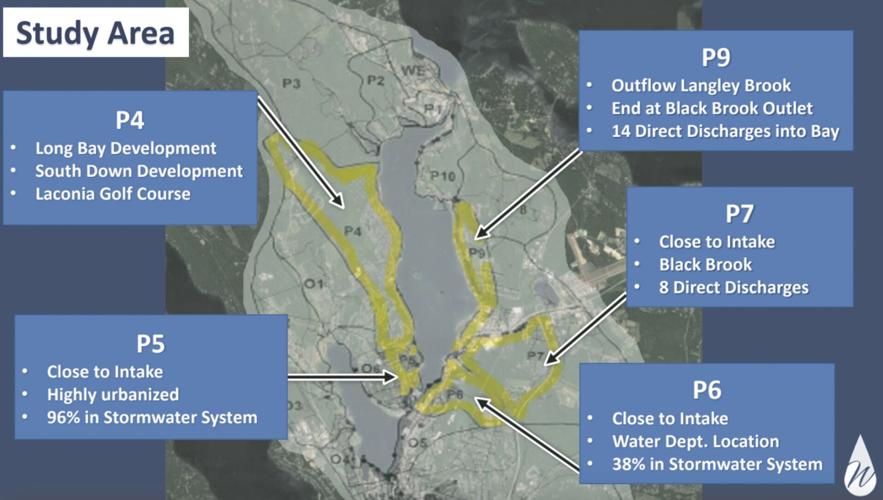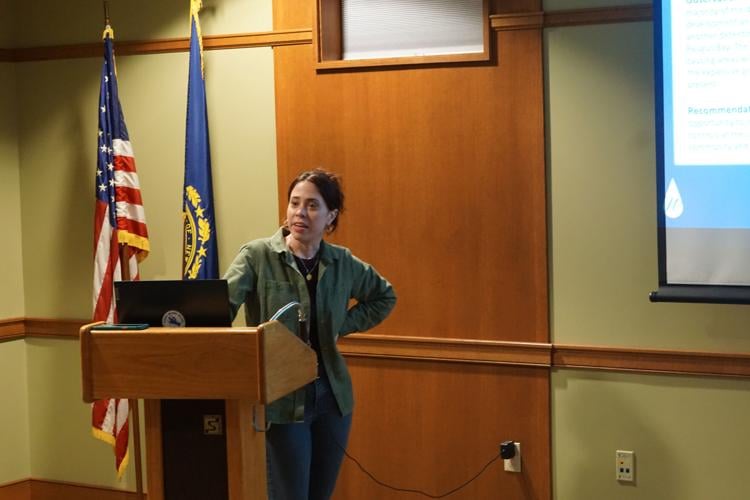LACONIA — After thorough study the results are in: the waters of Paugus Bay — the primary source of drinking water for the city — are generally very clean, but environmental contamination remains a major threat.
Lake Winnipesaukee Association Conservation Program Manager Bree Rossiter told a small crowd at the Laconia Public Library on Wednesday that the results of its Paugus Bay water quality study indicate highly urbanized areas surrounding the lake are simultaneously the most contaminated with blue-green algae called cyanobacteria and the most at-risk of further contamination.
The first bloom in Paugus Bay was documented in 2018.
“Paugus Bay is an extremely developed watershed for our source water protection area,” Rossiter said. “Increasing development on existing, outdated infrastructure is not sustainable for the long term.”
The Paugus Bay watershed contains over 6,000 acres. The bay itself begins at the Weirs Channel and exits to Lake Opechee through the Lakeport Dam. The entirety of Lake Winnipesaukee drains into Paugus Bay.
A study assessing the water quality and sources of pollution to Paugus Bay noted a recent increase in the number of cyanobacteria blooms identified there. The study, which was completed in collaboration between the Lake Winnipesaukee Association, the City of Laconia Water Department and the conservation commission, was facilitated by a New Hampshire Department of Environmental Services grant and investigated five areas of concern throughout the watershed.
Those groups performed water quality monitoring, completed a land-use model and conducted watershed and shoreline surveys to pinpoint specific areas in need of contamination mitigation. Organizers developed an action plan to reduce nutrient and sediment loading, a primary contributor to cyanobacteria blooms in Paugus Bay.
Phosphorus runoff is a primary factor to the problem, and developed areas of the watershed contained 5 to 10 times the amount of phosphorus runoff compared to forested areas. Phosphorus, which is introduced to the lake through sediment and other means, can find its way into the water after heavy rains or when fertilizers are applied near to the water. The phosphorus feeds cyanobacteria blooms.
“Phosphorus is present in urban and agricultural runoff and contributes to water pollution,” Rossiter said. “When stormwater washes over surfaces like roads and other fields, it can pick up that phosphorus.
"Also through failing septic systems, because phosphorus is present in human waste, and through erosion. Phosphorus binds to soil particles, you can think of it as something really sticky, so erosion from open areas or construction sites can also contribute phosphorus.”
Cyanobacteria is a natural aspect of the ecosystem but can, in higher volumes, create ecological problems and hazards to humans and animals. Exposure to high levels can be toxic and has resulted in health concerns for humans and even documented fatalities among animals, such as domesticated dogs.
“One thing to note about phosphorus as well is that one pound of phosphorus can support 500 pounds of algal growth, which is extremely significant,” she said.
The study identified polluted stormwater runoff, failing septic systems, erosion, recreational pressures, increased development and invasive plants and animals as primary contributors to cyanobacteria blooms. The catchment designed in the study as P5, which is highly urbanized, is the smallest among those included, but also has the highest level of phosphorus, nitrogen and sediment pollution per acre.
“Even though it’s the smallest catchment, it’s contributing the greatest load per area because of how urbanized it is,” Rossiter said.
Protecting stormwater outlets to prevent increased introduction of pollution into the bay is one several ways to make an impact.
“There are 154 stormwater outlets just within those catchments within the 250-foot protected shoreline zone,” Rossiter said. “There are 250 outlets, including the 154 within the catchments that we looked at, but 250 for the other areas of the watershed that we didn’t look at during our assessment.”
Conservation workers also performed a shoreline survey which included 141 parcels and assessed each parcel based on buffer width, amount of bare soil, evident shoreline erosion and the setback distance of structures there.
In their action plan, Rossiter noted public education and outreach is paramount. Associates of the Lake Winnipesaukee Association hope to improve public understanding of the importance of protecting Paugus Bay, the primary source of drinking water for the city.
Included in the plan are the completion of a design and construction of mitigation measures to address water contamination at the five top-priority sites identified by the study; to do the same at 17 medium- and low-priority sites; to educate shoreline property owners regarding the importance of revegetating shoreline buffers with native plants, reduce the amount of large, grassy areas and raising mower decks to at least 5 inches; and to provide technical assistance and cost sharing to watershed and shoreline property owners in order to install stormwater and erosion control mechanisms including rain gardens and shoreline buffers.
“Even though it’s not a focus of this grant, public education and outreach is a really important component of any action plan,” she said. “We’ll continue to educate all of our residents through our mission."
A collaborative effort between stakeholders is paramount to making progress to reduce water pollution, she noted. Above-ground water is a major contributor to the appeal of the Lakes Region, and protecting bodies such as Paugus Bay will help to ensure the area is pristine for years to come.
“We can work together to make a difference in our watershed,” Rossiter said.
The results of the study will soon be posted at winnipesaukee.org.



















(0) comments
Welcome to the discussion.
Log In
Keep it Clean. Please avoid obscene, vulgar, lewd, racist or sexually-oriented language.
PLEASE TURN OFF YOUR CAPS LOCK.
Don't Threaten. Threats of harming another person will not be tolerated.
Be Truthful. Don't knowingly lie about anyone or anything.
Be Nice. No racism, sexism or any sort of -ism that is degrading to another person.
Be Proactive. Use the 'Report' link on each comment to let us know of abusive posts.
Share with Us. We'd love to hear eyewitness accounts, the history behind an article.